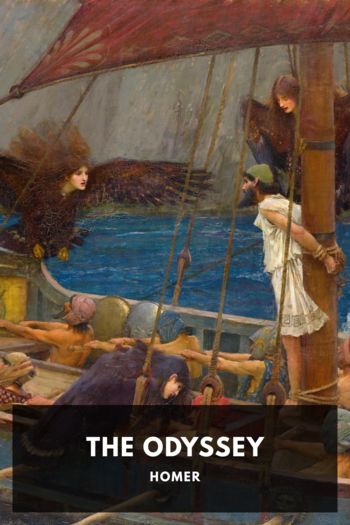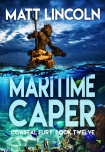The Saboteurs, Clive Cussler [dark academia books to read .txt] 📗

- Author: Clive Cussler
Book online «The Saboteurs, Clive Cussler [dark academia books to read .txt] 📗». Author Clive Cussler
Captain Grosse led them up the scissor stairs inside the mooring mast framework, returning salutes from two young airmen descending to the main deck. A third crew member guarded the entry hatch at the very front of the dirigible. He too saluted and let the party pass.
Just inside the door was the mechanical lever to release the locking pin holding the airship to the mast. In front of them were stairs that descended gently and followed the curve of the airship’s bow section. From there, it was eighty feet back to an access ladder that rose to the control gondola. During normal operations at an airfield, the mooring mast was much lower, and the gondolas could be accessed at ground level via regular doors.
The airship’s cockpit was a utilitarian space, with exposed wires and alloyed structural frameworks punched through with holes to reduce weight without sacrificing strength. The view outside was a two-hundred-and-eighty-degree panorama. There were two main control wheels, one for steering the ship left and right, the other to control altitude. Other controls mounted on panels were for ballast and venting hydrogen during flight. There were speaking tubes connected to the mechanics’ ready room to call for more or less airspeed. There was ample space for five, including a seat reserved for the Captain.
A tight corridor ran aft from the cockpit along the gondola’s left side. It linked several curtained-off spaces. One was for the airship’s wireless set. It was little more than a cramped cubbyhole with room for a single man and his gear. There was a lavatory, which was merely a seat with a hole to the wide world below, and three private rooms with cots for the officers. Writing desks could be folded down from the wall in each cabin, and uniforms and other gear were stored in bins under the narrow bedsteads.
Next came another short flight of stairs up into the hull of the airship, and a tunnel stretching back to the second gondola. There were a pair of ladders midway down the tunnel that gave access to the forward engine nacelles. At the end of the tunnel was yet another ladder. The rear gondola was larger than the control cabin and, for this trip, left almost completely empty except for a large winch and cable suspended over a door with long piano hinges in the cabin’s floor that could be opened. Next to it was the “cloud car.” The contraption resembled the cockpit of a wingless aircraft with a blunt yet still-aerodynamic nose and small fins at the rear.
“What’s this?” Talbot asked. “Looks flimsy.”
“It is far sturdier than it appears,” Captain Grosse said, displaying more than a little pride in the floating oddity. “It is an observation platform that we can lower from the ship. From it, a man with a compass, binoculars, and the speaking tube to the control gondola can act as navigator while the ship remains hidden in the clouds.”
Left unsaid was the observer’s more militaristic role of bombardier when the airship turned into a weapon of war.
“You Germans think of everything,” Talbot remarked. “When Otto told me his airship had a winch strong enough to lower the mines, I never thought to ask why. Darn clever, is what I thought.”
“This is how we located the Spatminster without the ship spotting us. We remained in some high clouds while our observer below scanned the seas. We will need to leave it behind to accommodate the second mine.”
“That brings up the question of the woman stashed in the chain locker.” This came from Captain Blucher, the Dagna’s commanding officer. “What is to be done with her?”
The men all looked to Otto Dreissen. The industrialist remained silent for several seconds, his face a stony mask, his icy gray eyes unreadable.
“I believe it is too late for her husband to stop us, at this point, so killing Mrs. Bell accomplishes nothing and serves to antagonize him further. She’s seen nothing but the inside of her blindfold and the inside of a metal storage locker. We will release her at our next port of call.”
“That would be Kingston,” Captain Blucher said. “We need some supplies for the hydrogen generator. I believe there is an American Consul in the city.”
Talbot said, “Which means Bell will head there from Panama to fetch her. But if something happens to her, I hope you go deep underground, Mr. Dreissen, because Isaac Bell is going to come after you like a just awoken grizzly bear.”
33
You’re sure you can fly this thing?” Sam Westbrook asked when the warehouse doors were fully opened and daylight shone on the wood and wire and canvas sculpture that was the Fowler-Gage biplane.
“Oh, yeah,” Bell said with longing in his voice. He couldn’t wait to take it up.
The fuselage and wings were yellow fabric over a wooden frame, and it looked far sturdier than some of the other planes Bell had flown. The eighty-horsepower Hall-Scott V8 motor was a veritable beast behind the big seven-foot propeller. The original landing gear had been replaced with a pontoon that jutted out ahead of the engine and prop. Two small outrigger floats were attached at the wingtips. The entire plane sat on a wheeled cart so it could be towed down to the water just east of the Authority’s administration building.
R. G. Fowler was painted on the fuselage in large black letters.
“And you get so much as one bug splatter on her, I’ll make sure that Mr. Fowler sues you into the poorhouse.” The speaker was none other than Jack Scully, the Authority’s chief mechanic.
“Not to worry, I’ve got plenty of flight time under my belt.”
Scully coughed from deep in his lungs and spat. “Can’t believe





Comments (0)